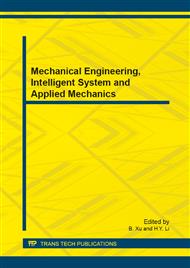[1]
P. Li, M. Salour, and X. Su, A survey of internet worm detection and containment, IEEE Communication Surveys & Tutorials, vol. 10, No. 1, 2008, pp.20-35.
DOI: 10.1109/comst.2008.4483668
Google Scholar
[2]
Su Fei, Lin Zhaowen, Ma Yan. Worm Propagation Modeling based on Two-Factor Model[C]. In: Pro. Of the IEEE, 2009, 978-1-4244-3693-4/09.
Google Scholar
[3]
Zou CC, Towley D, Gong W. Email virus propagation modeling and analysis. Technical Report, TR-03-CSE-04, (2003).
Google Scholar
[4]
D. Nicol, M. Liljenstam, and J. Liu, Multi-scale Modeling and Simulation of Worm Effects on the Internet Routing Infras- tructure[C]. International Conference on Modeling Techniques and Tools for Computer Performance Evaluation (Performance TOOLS), Urbana, IL, 2003. 1-10.
DOI: 10.1007/978-3-540-45232-4_1
Google Scholar
[5]
M. Liljenstam, Y. Yuan, B. Premore, and D. Nicol. A mixed abstraction level simulation model of large-scale internet worm infestations. In Proceedings of the, 2002 MASCOTS Conference, July (2002).
DOI: 10.1109/mascot.2002.1167067
Google Scholar
[6]
Deng Jie, Haixin Duan, Fine-granular Simulation and Modeling of Worm Propagation Using SSFNet[J]. Journal of Chinese Computer Systems. Vol. 29 No. 1 2008, pp.145-149.
Google Scholar
[7]
Provos N. A virtual honeypot framework. Technical Report, 03-1. Center of Information Technology Integration, University of Michigan, 2003. http: /www. citi. umich. edu/ techreports/reports/ citi-tr-03-1. pdf.
Google Scholar
[8]
Y Guo and M.L. Zhu, Research into agent-oriented worm defense system, Journal of Computer Applications, vol. 26, no. l2, pp.2931-2934, Dec. (2006).
Google Scholar
[9]
Castaneda Frank, Sezery Emre Can, Xu Jun. WORM vs WORM: Preliminary study of an active counterattack mechanism[C]. Staniford S. Proc of the ACM CCS Workshop on Rapid Malcode(WORM 2003). New York: ACM, 2004: 83-93.
DOI: 10.1145/1029618.1029631
Google Scholar
[10]
C. Kiddle, R. Simmonds, C. Williamson, and B. Unger, Hybrid Packet/Fluid Flow Network Simulation, presented at IEEE/ACM Workshop on Parallel and Distributed Simulation (PADS), San Diego, CA, (2003).
DOI: 10.1109/pads.2003.1207430
Google Scholar
[11]
Kalyan S Perumalla,Srikanth Sundaragopalan.High-fidelity modeling of computer network worms[C].In: Proceedings of the 20th Annual Computer Security Applications Conference (ACSAC'04),December 6-1 0, 2004.
DOI: 10.1109/csac.2004.21
Google Scholar


